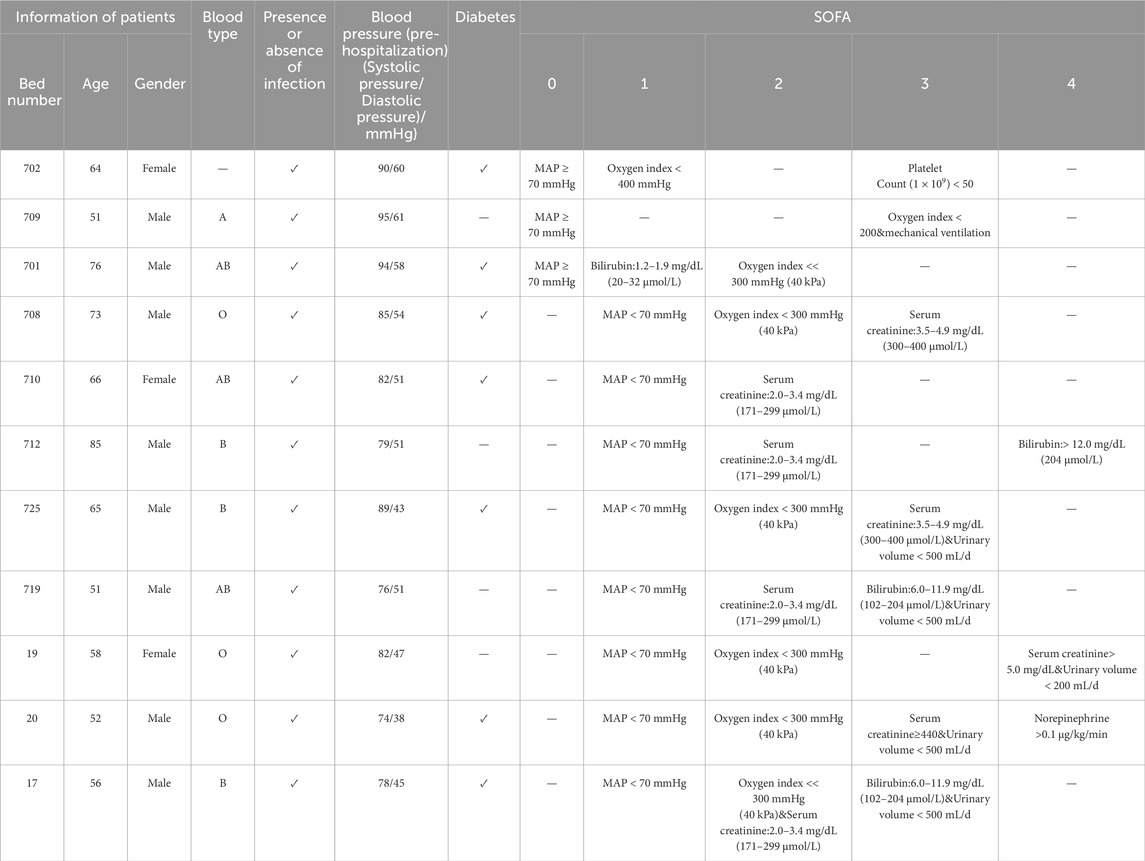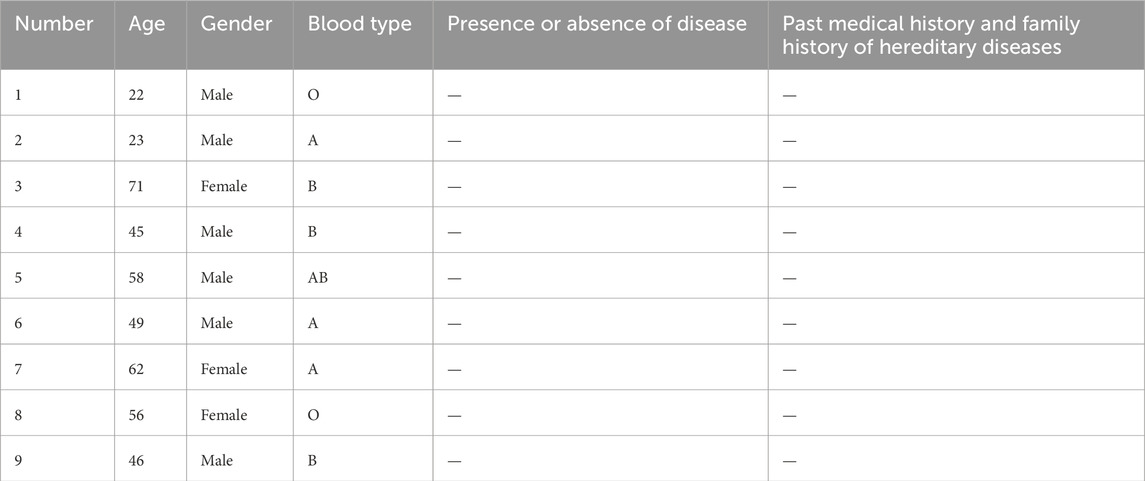- 1Department of Emergency Surgery, The First Affiliated Hospital of Bengbu Medical University, Bengbu, Anhui, China
- 2School of Life Science, Anhui Agriculture University, Hefei, China
- 3Institute of Emergency and Critical Care Medicine, The First Affiliated Hospital of Bengbu Medical University, Bengbu, China
Introduction: Sepsis is a life-threatening condition caused by a dysregulated immune response to infection. Despite advances in clinical care, effective biomarkers for early diagnosis and prognosis remain lacking. Emerging evidence suggests that histone acetylation plays a crucial role in the pathophysiology of sepsis.
Methods: Transcriptomic and single-cell RNA sequencing data were used to identify histone acetylation-related genes. Differential expression analysis and weighted gene co-expression network analysis (WGCNA) were performed, followed by machine learning algorithms (LASSO, SVM-RFE, and Boruta) to screen for potential biomarkers. Mendelian randomization (MR), RT-qPCR, and functional assays were conducted for validation.
Results: BLOC1S1, NDUFA1, and SFT2D1 were identified as key biomarkers. A predictive nomogram demonstrated strong diagnostic potential. Immune infiltration and single-cell analyses linked the biomarkers to macrophage activity. MR analysis confirmed SFT2D1 as a causal factor in sepsis. Functional assays showed that knockdown of SFT2D1 suppressed CXCL10 and IL-6 expression, indicating its pro-inflammatory role.
Discussion: This study identifies novel biomarkers associated with histone acetylation and immune dysregulation in sepsis. These findings deepen our understanding of sepsis pathogenesis and may facilitate the development of improved diagnostic and therapeutic strategies.
1 Introduction
Sepsis is a severe, life-threatening systemic inflammatory condition that arises from a dysregulated host response to infection. It is a major global health issue, with high incidence and mortality rates, particularly in critically ill patients (Singer et al., 2016). Sepsis can lead to multi-organ dysfunction, with the lungs being one of the most vulnerable organs, often affected early in the disease process (Su et al., 2024). Despite advances in antimicrobial therapy and organ support, sepsis remains the leading cause of death in intensive care units. Early diagnosis and intervention are crucial to improving patient outcomes, yet effective biomarkers for the early detection and prognosis of sepsis are still lacking.
Recent research has highlighted the critical role of epigenetic modifications, particularly histone acetylation, in the progression of sepsis. Histone acetylation, a reversible post-translational modification catalyzed by histone acetyltransferases and deacetylases, influences chromatin structure and gene expression (Wu et al., 2024). This process has profound effects on immune cell function and contributes to immune reprogramming during sepsis. Dysregulation of histone acetylation can alter the host’s immune responses, leading to persistent immune suppression and chronic inflammation (Li et al., 2024a; Li et al., 2024b; Sun et al., 2021). Understanding the mechanisms of histone acetylation in sepsis could provide new avenues for developing diagnostic biomarkers and therapeutic targets.
In this study, we utilized bioinformatics and single-cell RNA sequencing (scRNA-seq) to identify histone acetylation-related biomarkers in sepsis and elucidate their molecular and immunological mechanisms. By integrating transcriptomic data with Mendelian randomization (MR) analysis and immune cell profiling, we aimed to uncover critical pathways and regulatory networks associated with these biomarkers. These findings could contribute to improving early diagnosis, risk stratification, and personalized therapeutic approaches for sepsis.
2 Materials and methods
2.1 Data collection
The training cohort (GSE95233), validation cohort (GSE65682), and single-cell RNA sequencing (scRNA-seq) dataset (GSE167363) for sepsis were downloaded from the Gene Expression Omnibus (GEO) database (https://www.ncbi.nlm.nih.gov/geo). Specifically, the GSE95233 dataset, was utilized the GPL570 platform, included blood samples from 22 controls and 102 sepsis (Tabone et al., 2018; Venet et al., 2017). The header of the GSE95233 dataset was described as the robust multi-array average (RMA) signal intensity (log base 2). The GSE65682 dataset, was based on the GPL13667 platform, comprised blood samples from 42 controls and 51 sepsis (Scicluna et al., 2015; van Vught et al., 2016). The header of the GSE65682 dataset was described as the RMA normalized log2 transformed values. The scRNA-seq dataset GSE167363, was derived the GPL24676 platform, contained peripheral blood mononuclear cells from 2 controls and 10 sepsis (Qiu et al., 2021). Detailed information about the subjects in the three datasets were shown in Supplementary Tables S1–S3. Additionally, 77 histone acetylation-related genes (HARGs) were obtained from the literature (Qin et al., 2024).
2.2 Differential expression analysis
The limma package (v 3.52.4) (Ritchie et al., 2015) was utilized to perform differential analysis between sepsis and control samples on the training cohort. The threshold for differentially expressed genes (DEGs) was set |log2 fold change| > 0.5 and P < 0.05. The ggplot2 package (v 3.3.6) (Xu et al., 2024) was used to plot the volcano plot, and the ComplexHeatmap package (v 2.20.0) (Gu and Hubschmann, 2022) was employed to generate heatmap illustrating the expression of DEGs in Sepsis.
2.3 Weighted gene co-expression network analysis (WGCNA)
HARGs served as the background gene set, and the ssGSEA algorithm from the GSVA package (v 1.44.5) (Gui et al., 2024) was used to calculate the HARGs score across all samples in the training set, and to compare the differences in HARGs scores between the sepsis and control groups. Based on the training set, the WGCNA package (v 1.72.5) (Langfelder and Horvath, 2008) was employed to construct a co-expression network. Prior to network construction, cluster analysis was conducted on the samples to identify and exclude outlier samples. When selecting the soft-thresholding power, we adhered to the criteria that the scale-free R2 value should be close to 0.9 and the mean connectivity should approach 0, ensuring that the network structure conformed to the scale-free distribution characteristic. Subsequently, a minimum of 200 genes was set for each gene module as a basis for module division. Following that, a Spearman correlation analysis was conducted between the obtained gene modules and the HARGs score of the samples, with the aim of identifying the key modules and their key module genes that had the highest absolute correlation with the HARGs scores.
2.4 Identification and enrichment analysis of candidate genes
The ggvenn package (v 0.1.9) (Zheng et al., 2024) was utilized to identify the intersection between DEGs and key module genes, thereby determining candidate genes. Subsequently, the clusterProfiler package (v 4.7.1.001) (Yu et al., 2012) conducted Gene Ontology (GO) and Kyoto Encyclopedia of Genes and Genomes (KEGG) enrichment analyses for these candidate genes with P < 0.05. The ggplot2 package was employed to visualize the enrichment results. Additionally, the STRING database (http://string.embl.de/) was used to construct a protein-protein interaction (PPI) network for the candidate genes with a confidence score of ≥0.4.
2.5 Selection of biomarkers
Machine learning algorithms were employed to screen candidate genes for the identification of potential biomarkers. Initially, the glmnet package (v 4.1.8) (Friedman et al., 2010) was used to perform least absolute shrinkage and selection operator (LASSO) analysis on the candidate genes, with model performance optimized through 10-fold cross-validation. Subsequently, the e1071 package (v 1.7.14) (Zhang et al., 2024) was utilized to conduct support vector machine-recursive feature elimination (SVM-RFE) analysis on the features obtained from the LASSO analysis, aiming to identify the feature genes with the lowest error rate. Finally, the Boruta package (v 8.0.0) (Liu Q. et al., 2023) was utilized to perform Boruta analysis on the feature genes derived from the SVM-RFE analysis, to screen out the final candidate biomarkers. The selection process was required to identify the final biomarkers. The pROC package (v 1.18.0) (Wang et al., 2023) was utilized to plot the receiver operating characteristic (ROC) curves for genes in the training and validation cohorts, with the aim of evaluating the diagnostic performance of candidate biomarkers. Subsequently, box plots were employed to illustrate the expression differences of genes with area under the curve (AUC) values ≥0.7 between sepsis and control samples within these two cohorts. Genes that exhibited significant and consistent trends were defined as biomarkers.
2.6 Reverse transcription-quantitative polymerase chain reaction (RT-qPCR) validation and function analysis of the selected biomarkers
2.6.1 Cell culture and sepsis model construction
The THP-1 cell line was obtained from the American Type Culture Collection (ATCC) and cultured in RPMI-1640 medium supplemented with 10% fetal bovine serum (FBS, HyClone) and 100 U/mL penicillin-streptomycin in a 37°C incubator with 5% CO2. To establish an in vitro sepsis model, THP-1 monocytes were differentiated into macrophages by treating them with 100 nM phorbol 12-myristate 13-acetate (PMA) for 48 h. Following differentiation, the macrophages were stimulated with 1 µg/mL lipopolysaccharide (LPS) for 24 h to induce a sepsis-like inflammatory response.
2.6.2 Clinical sample collection
Peripheral blood samples were collected from sepsis patients diagnosed based on Sepsis-3 criteria at The First Affiliated Hospital of Bengbu Medical University and from healthy volunteers as controls. Specifically, the diagnosis of sepsis was based on the following criteria: (Singer et al., 2016) confirmed diagnosis of sepsis based on clinical and laboratory indicators; (Su et al., 2024) age between 18 and 75 years; and (Wu et al., 2024) provision of written informed consent by the patient or legal representative. Exclusion criteria included: (Singer et al., 2016) age <18 years; (Su et al., 2024) pregnancy; (Wu et al., 2024) presence of malignant tumors; (Li et al., 2024a) autoimmune diseases; (Li et al., 2024b) recent surgery or trauma; (Sun et al., 2021) acute or chronic aseptic inflammation; (Tabone et al., 2018) chronic organ dysfunction; (Venet et al., 2017); hematological disorders; (Scicluna et al., 2015) other infections unrelated to sepsis; (van Vught et al., 2016); treatment with immunosuppressive agents; (Qiu et al., 2021) patients admitted for palliative care only; (Qin et al., 2024) existence of an advanced directive to withhold or withdraw life-sustaining treatment; or (Ritchie et al., 2015) patients or legal representatives unwilling or unable to provide informed consent. Healthy controls had no history of infection, immune-related disease, chronic illness, or medication use at the time of sample collection.
A total of 20 samples (11 sepsis and 9 healthy controls) were used for RT-qPCR validation (Tables 1, 2). Total RNA was extracted from whole blood using the TRIzol reagent following the manufacturer’s protocol. The study was approved by the hospital’s Ethics Committee, and Informed consent was obtained from all participants.
2.6.3 RNA extraction and RT-qPCR analysis
Total RNA was extracted from LPS-stimulated THP-1 macrophages and patient blood samples using TRIzol reagent (Invitrogen, United States), according to the manufacturer’s protocol. To ensure the integrity and reliability of the collected samples, all peripheral blood specimens were processed within 2 h of collection. The concentration and purity of RNA were assessed using a NanoDrop One spectrophotometer (Thermo Fisher Scientific), ensuring an 260/280 ratio between 1.8 and 2.1. For cDNA synthesis, 500 ng of total RNA was reverse transcribed using the TransScript All-in-one First Strand cDNA Synthesis Kit (Transgenbiotech AT-341), and RT-qPCR analysis was conducted with SYBR Green-based detection (Transgenbiotech AQ-601) on a Real-Time PCR system (Applied Biosystems). The RT-qPCR conditions were initial denaturation at 94°C for 30 s, followed by 40 cycles of 94°C for 5 s and 60°C for 30 s. All reactions were performed in triplicate. Gene-specific primers (Table 3) were used for the amplification of BLOC1S1, NDUFA1, SFT2D1, CXCL10, and IL-6, with GAPDH serving as an internal control. The delta(d)CT method was employed to calculate the relative expression levels of the target genes relative to internal control gene (GAPDH) in a single sample. The ddCT method, based on the dCT calculation, was further employed to compare the relative expression changes of the target gene between the experimental group and the control group. Finally, the formula 2−ΔΔCt was used to calculate the relative expression of the target gene. Data are presented as mean ± SD from at least three independent experiments (Livak and Schmittgen, 2001).
2.6.4 SFT2D1 knockdown and inflammatory cytokine assessment
To investigate the function of SFT2D1 in sepsis, small interfering RNA (siRNA) targeting SFT2D1, and a scrambled siRNA control were transfected into THP-1 macrophages using Lipofectamine RNAiMAX (Invitrogen) according to the manufacturer’s protocol. After 48 h of transfection, the cells were stimulated with 1 µg/mL LPS for 24 h, followed by RNA extraction. The efficiency of SFT2D1 knockdown was confirmed by RT-qPCR. Additionally, the mRNA expression levels of CXCL10 and IL-6 were assessed to evaluate the inflammatory response.
2.7 Construction of the nomogram
Based on the expression of biomarkers, the rms package (v 6.8–1) (Wang et al., 2024) was used to construct nomogram. To assess the accuracy of the nomogram, calibration curve was plotted. Calibration curve is an essential tool for evaluating the accuracy of predictive models, as they assess the calibration of the model by comparing predicted probabilities with actual observed outcomes. Additionally, ROC curves for the nomogram were plotted to evaluate their diagnostic performance.
2.8 Immune infiltration analysis
The ssGSEA algorithm from the GSVA package was employed to calculate the scores of 28 immune cell types in all samples within the training set. Histogram of immune infiltration was plotted to compare the infiltration proportions of immune cell types across different samples. Additionally, box plot was used to display the differences in the 28 immune cell types between groups. The ggcor package (v 0.9.8.1) (Ban et al., 2024) was utilized to generate a correlation heatmap to analyze the correlation between biomarkers and differential immune cells.
2.9 Drug prediction and molecular docking
Relying on the CoreMine database (https://coremine.com/medical/?locale=zh_CN#search), drugs associated with biomarkers were predicted. Subsequently, Cytoscape software (v 3.7.1) (Shannon et al., 2003) was employed to construct and visualize the network relationships between biomarkers and drugs. Based on the ranking of network connectivity, the drug-biomarker pairs with the highest connectivity are selected for molecular docking. The 3D structural files of drugs were obtained using the PubChem database (https://pubchem.ncbi.nlm.nih.gov/) and Babel GUI software. Concurrently, the protein 3D structures of biomarkers were downloaded from the UniProt database (https://www.uniprot.org). Thereafter, AutoDockTools software was utilized to optimize these structures and perform molecular docking. Finally, the results were visualized using PyMOL software.
2.10 Gene set enrichment analysis (GSEA) and gene set variation analysis (GSVA)
Utilizing the KEGG gene sets provided by the msigdbr package (v 7.5.1) (Long et al., 2023), the clusterProfiler package was employed to perform GSEA. This process was based on the expression levels of individual biomarkers and used the correlation coefficient as the basis for sorting, with |NES| > 1 and adj. P < 0.05. Additionally, for the GO background gene sets provided by the msigdbr package, the GSVA and limma packages were used to conduct GSVA on the sepsis and control samples in the training set, with thresholds of |t| > 2 and P < 0.05.
2.11 Construction of regulatory networks for biomarkers
The transcription factors (TFs) corresponding to the biomarkers were retrieved using the JASPAR database (https://jaspar.elixir.no/). Following this, the microRNAs (miRNAs) corresponding to the biomarkers and the long non-coding RNAs (lncRNAs) associated with these miRNAs, with clipExpNum >60, were searched in the Starbase database (https://rnasysu.com/encori/). To visually represent these complex molecular networks, the biomarker-TF and mRNA-miRNA-lncRNA networks were visualized using the software Cytoscape.
2.12 Mendelian randomization (MR) analysis
Utilizing biomarkers as exposure factors and sepsis as the outcome, MR analysis was conducted. Single nucleotide polymorphisms (SNPs) were employed as instrumental variables (IVs), with three primary assumptions (Singer et al., 2016): There is a significant association between SNPs and biomarkers (Su et al., 2024); SNPs are independent of potential confounding factors (Wu et al., 2024); The effect on sepsis occurs solely through the biomarkers. The genome-wide association study (GWAS) data on sepsis and expression quantitative trait locus (eQTL) data for biomarkers (Supplementary Table S4) were obtained from the IEU OpenGWAS database (https://gwas.mrcieu.ac.uk/). The sepsis dataset, ieu-b-4980, included 11,643 sepsis and 474,841 control European samples, totaling 12, 243, 539 SNPs. This study followed the STROBE-MR reporting norms (Skrivankova et al., 2021).
The TwoSampleMR package (v 0.6.3) (Chen et al., 2024) was utilized for the reading and filtering of exposure SNPs, with a stringent set for P < 5^10−8. The ld_clump() function from the ieugwasr package (v 1.0.0) (Fan et al., 2024) as employed to remove SNPs with linkage disequilibrium, with parameters set at r2 = 0.001 and kb = 10,000. Additionally, we selected IVs with an F-statistic greater than 10 to further exclude the possibility of weak IVs. Confounding factors such as “smoking status measurement”, “systolic blood pressure”, “smoking status measurement”, “diastolic blood pressure”, “smoking behavior”, “body mass index”, “type 2 diabetes mellitus”, “rheumatoid arthritis”, “cardiovascular disease”, “cardiovascular disease biomarker measurement”, “latent autoimmune diabetes in adults”, “type 2 diabetes mellitus”, “psoriasis”, “type 2 diabetes mellitus”, “smoking status measurement”, “rheumatoid arthritis”, “ACPA-positive rheumatoid arthritis”, “rheumatoid factor seropositivity measurement”, “rheumatoid arthritis”, “anti-citrullinated protein antibody seropositivity”, and “rheumatoid factor seropositivity measurement” were excluded through the GWAS catalog database (https://www.ebi.ac.uk/gwas/). The harmonise_data function from the TwoSampleMR package was used to harmonize effect alleles and effect sizes, and to exclude IVs significantly associated with the outcome. Five algorithms were employed for MR analysis, including MR Egger (Burgess and Thompson, 2017) (PMID: 28527048), weighted median (Bowden et al., 2016), inverse variance weighted (IVW) (Ding et al., 2023), simple mode (Zeng et al., 2023), and weighted mode (Zeng et al., 2023), with IVW considered the definitive analytical method. In addition, Steiger test was performed to determine the directionality of the relationship between the biomarker and sepsis.
Heterogeneity was assessed using Cochran’s Q test, with results considered reliable when the P was greater than 0.05. Additionally, the MR-Egger intercept test was used to determine horizontal pleiotropy. Finally, leave-one-out approach was utilized to identify influential outliers by sequentially removing individual SNPs and re-estimating the causal effects.
2.13 ScRNA-seq analysis
First, the Seurat package (v 5.1.0) (Hao et al., 2024) was utilized for preprocessing and data filtering on the GSE167363 dataset. The specific steps included removing genes detected in fewer than 200 cells and excluding cells with nFeature_RNA (the number of genes in each cell) ≥ 4,000, nCount_RNA (the total RNA count per cell) ≥ 20,000, and the proportion of mitochondrial gene expression ≥10. Subsequently, the data underwent logarithmic normalization, and the variance stabilizing transformation (vst) method was applied to select genes with high variability between cells. The top 2,000 highly variable genes (HVGs) were selected for visualization. To reduce data dimensionality, principal component analysis (PCA) was performed. The JackStrawPlot and JackStraw functions were utilized to assess the significance of the principal components (PCs), thereby selecting an appropriate number of PCs for subsequent analysis. The FindNeighbors and FindClusters functions within the Seurat package were used for unsupervised clustering of cells, with a resolution set to 0.1, and Uniform Manifold Approximation and Projection (UMAP) clustering method was applied for cell clustering. The cellmarker2.0 database (http://117.50.127.228/CellMarker/) and the literature (Zhao et al., 2023) were utilized to provide detailed annotations for the clusters obtained. Bubble plot was used to visualize the expression of biomarkers in different cell clusters, and box plots were employed to show the differences in biomarker expression across cell types between sepsis and control groups. Additionally, the monocle package (v 2.26.0) (Chen et al., 2024) was used for pseudotime analysis of cells, and the CellChat package (v 1.6.1) (Huang et al., 2024) was utilized for cell communication analysis.
2.14 Statistical analysis
All analyses were conducted in R version 4.4.1, with inter-group differences assessed using Wilcoxon test, establishing a significance level at P < 0.05. A Spearman correlation analysis was conducted between the obtained gene modules and the HARGs score of the samples. For RT-qPCR validation experiments, data are presented as mean ± standard deviation (SD) from at least three independent biological replicates. Group comparisons were performed using a multiple t-test when comparing two groups, and one-way ANOVA for multiple group comparisons. Statistical significance was defined as P < 0.05. Where applicable, P values were corrected for multiple comparisons using the Dunnett method.
3 Result
3.1 Potential functional characteristics of candidate genes
A total of 3,874 DEGs between sepsis and control samples were identified from the training cohort, of which 2,114 were upregulated while 1,760 downregulated (Figures 1A,B)Prior to performing WGCNA, differential analysis of the HARGs score was conducted between the sepsis and control groups. The results revealed a significant difference (P < 0.05) between the two groups, indicating that the HARGs score was a valid phenotypic indicator suitable for subsequent analysis (Figure 1C). Cluster analysis of all samples confirmed the absence of outlier samples (Figure 1D). The optimal soft-thresholding power for achieving a scale-free network distribution was determined to be 10 (Figure 1E). And based on this, a minimum of 200 genes per gene module was set, ultimately identifying 11 gene modules (Figure 1F). Among these modules, the MEgreen module (cor = −0.48, P < 0.001) showed the highest correlation with the HARGs score and was thus identified as the key module, encompassing 763 key module genes (Figure 1G). By performing an intersection analysis between DEGs and key module genes, 281 potential candidate genes were filtered out (Figure 2A).
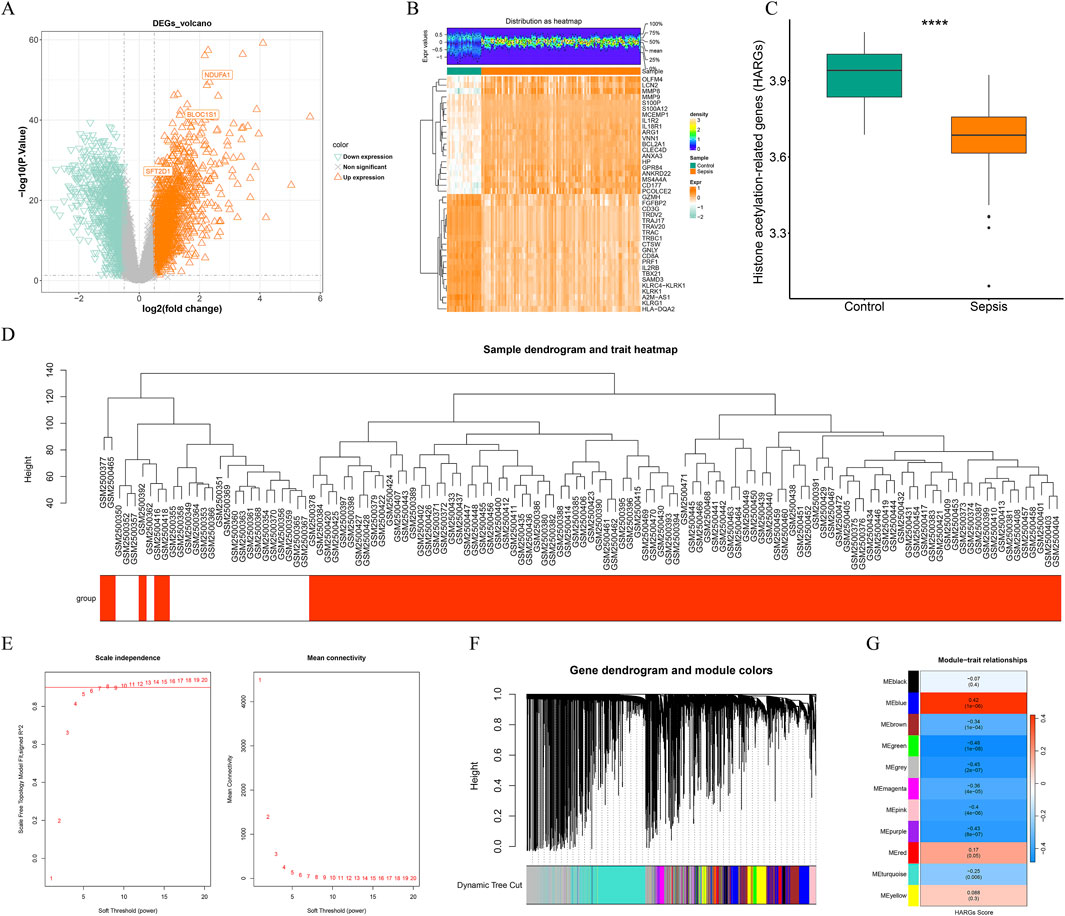
Figure 1. Differential expression analysis and weighted gene co-expression network analysis (WGCNA). (A) volcano map of differentially expressed genes (DEGs) between sepsis and control groups in the GSE95233. (B) heatmap of top 20 DEGs between sepsis and control samples. (C) histone acetylation-related genes (HARGs) score difference between sepsis and control groups. ****, P < 0.0001. (D) sample clustering tree. Red is the disease sample, white is the control sample. (E) the network approached the scale-free distribution when the ordinate R2 on the left was close to the threshold of 0.9 and the average connectivity on the right was close to 0. The optimal soft threshold was 10. (F) dynamic clipping tree of the 11 modules. (G) the heatmap showed the correlation of modules with HARGs score. MEgreen, the module with the highest absolute correlation with HARGs score, was selected as the key module, with a total of 763 genes.
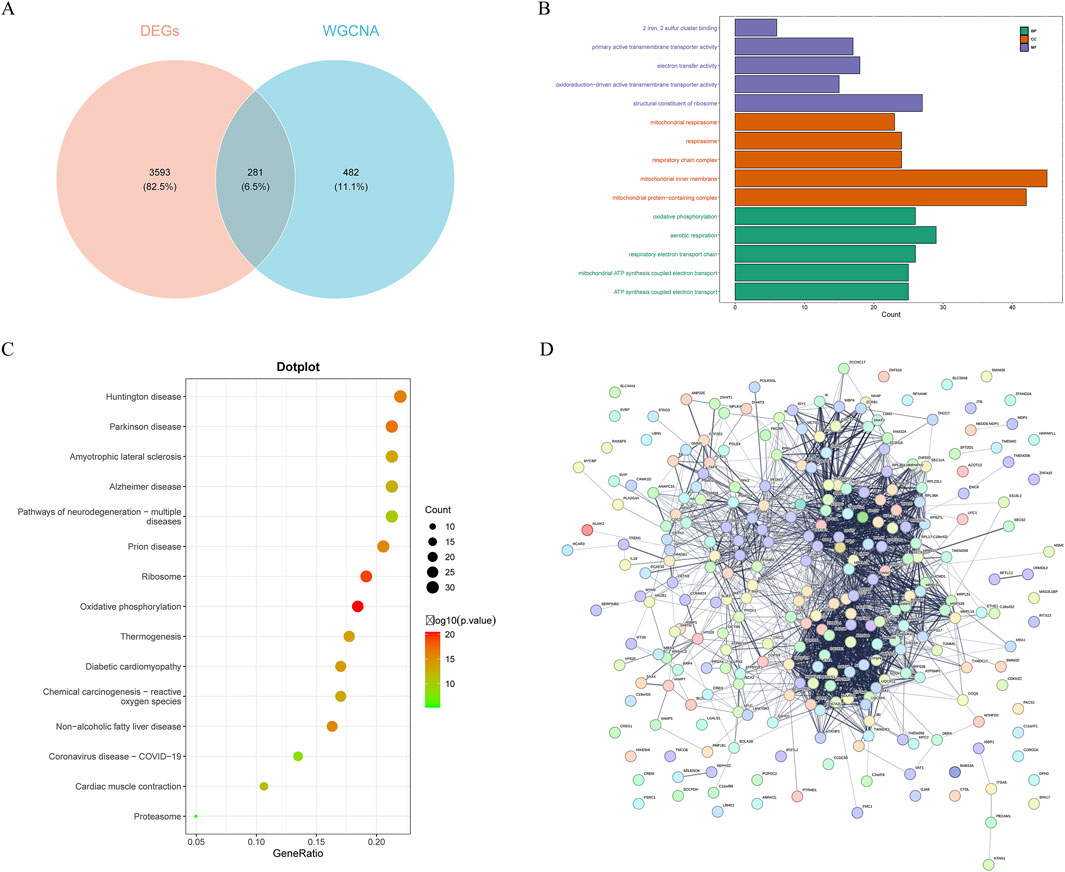
Figure 2. Screening and protein-protein interaction (PPI) network of candidate genes. (A) the intersection of DEGs, key module genes, HARGs resulted in 281 candidate genes. (B) Gene ontology (GO) enrichment analysis of candidate genes. Biological process, BP; cellular component, CC; molecular function, MF. (C) Kyoto Encyclopedia of Genes and Genomes (KEGG) enrichment analysis of candidate genes. (D) PPI network of candidate genes.
Enrichment analysis can identify specific features or functions that are significantly enriched from a large amount of data, aiding in the understanding of the functions of genes within cells, the biological processes they participate in, and their interrelationships. Therefore, enrichment analysis on these candidate genes was conducted. The GO enrichment analysis yielded 332 entries, with 186 significantly enriched in biological processes, 95 enriched in cellular components, and 51 enriched in molecular functions (Figure 2B). Histone modification-related terms such as “histone exchange”, “negative regulation of protein modification by small protein conjugation or removal”, and “regulation of protein modification by small protein conjugation or removal” were significantly enriched, suggesting that the candidate genes might play a key role in regulating gene expression and chromatin structure. Additionally, mitochondrial-related pathways also showed enrichment, including “mitochondrial ATP synthesis coupled electron transport”, “mitochondrial protein-containing complex”, “mitochondrial inner membrane”, and “mitochondrial respirasome”, emphasizing the potential role of candidate genes in mitochondrial function and energy metabolism. KEGG pathway enrichment analysis identified 24 significantly enriched pathways, mainly enriched in “proteasome”, “protein processing in endoplasmic reticulum”, and “ribosome” (Figure 2C). These pathways were closely related to protein degradation, processing, and synthesis, further confirming the central role of candidate genes in protein metabolism.
To gain a deeper understanding of the functions of the candidate genes and their mechanisms of interaction, PPI network was constructed for the candidate genes. This network comprised 265 nodes and 2,130 PPI pairs (Figure 2D). It was evident that multiple genes had close relationships with other genes, reflecting their complex interactions within the organism. For instance, genes like RPS24, COX5B, and ETFA showed a high degree of interactivity in the network, which might imply their significant role in cellular functions.
3.2 Identification of BLOC1S1, NDUFA1, and SFT2D1 as biomarkers through machine learning
With the advancement of machine learning techniques, we were capable of more accurately identifying genes of significant biological importance from complex data sets. Leveraging this, we employed a stepwise machine learning approach to screen out more critical genes from a pool of candidates. Through LASSO regression analysis, we successfully identified 10 genes (Lambda.min = 0.003), including NDUFA1, BLOC1S1, UFD1L, ZMAT2, SFT2D1, SEPHS2, JTB, RALY-AS1, C15orf54, and MYH9 (Figure 3A). Subsequently, SVM-RFE analysis was conducted on these 10 genes, and at a minimum error rate of 0.00595, all 10 genes were confirmed as feature genes (Figure 3B). Furthermore, Boruta analysis reaffirmed these 10 genes as important feature genes (Figure 3C). Thus, these 10 genes were considered candidate biomarkers. Cross-validation through multiple methods was employed to screen for biomarkers. Initially, BLOC1S1, NDUFA1, and SFT2D1 demonstrated AUC values of ≥0.70 in both the training and validation sets, indicating good diagnostic efficacy (Figure 3D). Subsequently, the expression levels of these 10 genes in sepsis and control samples were analyzed in the training and validation sets, and the results showed that BLOC1S1, NDUFA1, and SFT2D1 were significantly different in the training and validation sets, and the AUC values for these three genes were ≥0.70 (P < 0.001) (Figure 3E). Therefore, BLOC1S1, NDUFA1, and SFT2D1 were identified as the final biomarkers.
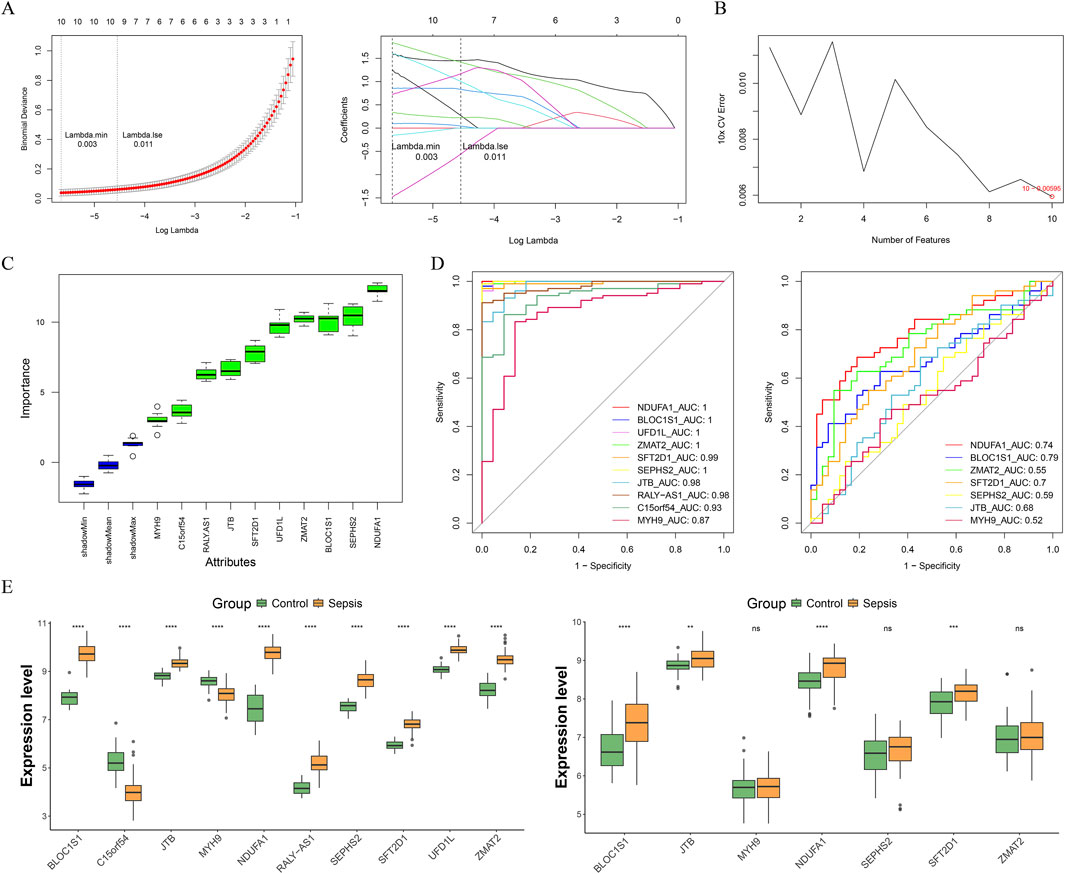
Figure 3. Acquisition of biomarkers. (A) least absolute shrinkage and selection operator (LASSO) regression analysis was performed for 10-fold cross-validation of the screened genes to obtain 10 characterized genes. (B) support vector machine-recursive feature elimination (SVM-RFE) analysis on the features obtained from the LASSO analysis. (C) Boruta agorithm screens for candidate biomarkers from the SVM-RFE analysis. Green represents important feature. (D) receiver operating characteristic (ROC) curves of candidate biomarkers in the training and validation sets. Genes with area under the curve (AUC) values ≥0.7 were screened to obtain BLOC1S1, NDUFA1, and SFT2D1. (E) expression box maps of candidate biomarkers between control and sepsis samples were used in the training dataset (left) and validation dataset (right) to screen for genes with exhibited significant and consistent trends. ***, P < 0.001; ****, P < 0.0001.
3.3 Characterizing the function of biomarkers and sepsis
GSEA provides a global perspective to reveal overall patterns of biological processes in gene expression data. Based on this, GSEA was performed on the biomarkers to uncover gene expression patterns associated with specific biological pathways (Figures 4A–C). The results showed that multiple pathways, including “oxidative phosphorylation”, “antigen processing and presentation”, “proteasome”, “ribosome”, and “FC gamma R-mediated phagocytosis”, were significantly enriched in BLOC1S1, NDUFA1, and SFT2D1. These findings indicated that the biomarkers played a significant role in energy metabolism, immune response, and protein homeostasis. Additionally, the “toll-like receptor signaling pathway” was activated in BLOC1S1 and SFT2D1, which might indicate a key regulatory mechanism of the inflammatory response in sepsis.
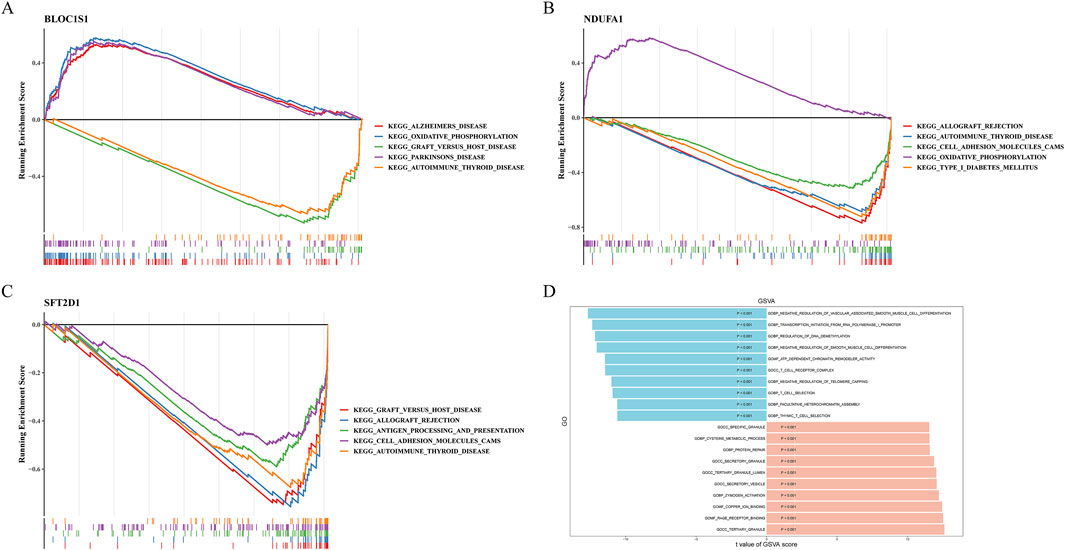
Figure 4. Gene set enrichment analysis (GSEA) and gene set variation analysis (GSVA). (A–C) GSEA of BLOC1S1, NDUFA1, and SFT2D1, respectively. (D) compare with control group, GSVA of sepsis group.
GSVA can reveal changes in biological processes and signal pathways by assessing the activity changes of predefined gene sets in different samples. Using this method, we explored pathways related to sepsis (Figure 4D). The GSVA results further revealed that T cell-related pathways were suppressed in sepsis, including “thymic T cell selection”, “T cell selection”, and “T cell receptor complex”. The suppression of these pathways might be associated with abnormal T cell function in sepsis, affecting the immune response. Moreover, pathways related to regulation, such as “negative regulation of telomere capping” and “regulation of DNA demethylation”, were also suppressed. The suppression of these pathways might be related to abnormalities in cellular senescence and epigenetic regulation. In contrast, “RAGE receptor binding”, “protein repair”, and “secretory vesicle” were activated in sepsis. The activation of these pathways might be related to the inflammatory response, cellular damage, and repair mechanisms in sepsis.
3.4 Nomogram for predicting sepsis risk
Nomogram, as an intuitive predictive tool, can integrate multiple biomarkers to forecast an individual’s risk of disease. By incorporating the three identified biomarkers BLOC1S1, NDUFA1, and SFT2D1 into the nomogram model, we have established a comprehensive diagnostic tool (Figure 5A). To ensure the predictive accuracy of the nomogram, calibration curve was employed for validation. The slope of the calibration curve being close to one indicated that our nomogram model was highly accurate in predicting disease risk (Figure 5B). Furthermore, the diagnostic efficacy of the model was assessed using the ROC curve. The AUC value of the nomogram reached 1, which, while indicating that the model has extremely high efficacy in distinguishing between diseased and non-diseased individuals, also suggested a potential for overfitting (Figure 5C). Nonetheless, the model’s effectiveness in disease diagnosis remained significant, providing clinicians with a powerful tool to aid in making more accurate diagnostic decisions. This offered a new perspective for the early diagnosis of the disease and personalized treatment.
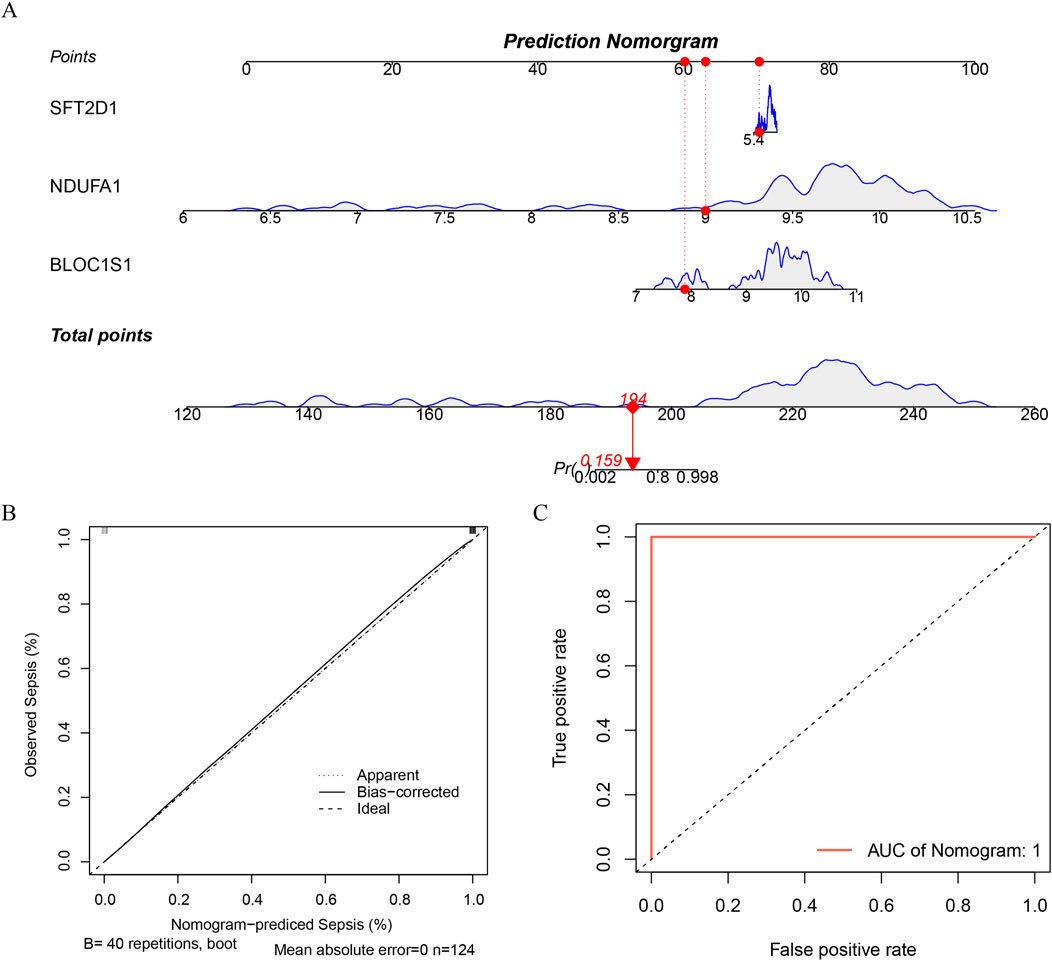
Figure 5. Construction of a nomogram. (A) construct a nomogram based on the expression of each biomarker. (B) calibration curve of nomogram. (C) ROC curve of nomogram.
3.5 Immune cells infiltration of biomarkers in sepsis
Immune cells play a pivotal role in the complex physiological dysregulation triggered by sepsis, with their behavior changes being directly associated with disease progression (Wang et al., 2022). Through immune infiltration analysis, we explored the immunological alterations in sepsis. In addition, the histogram of immune infiltration was constructed to visually display the differences in immune cell scores between sepsis and control samples (Figure 6A). Notably, there was a significant difference in the scores of 23 immune cell types between groups (Figure 6B). Activated B cells and Activated CD8 T+ cells showed lower infiltration levels in sepsis, while activated dendritic cells, neutrophils, and type 17 T helper cells exhibited higher infiltration levels in sepsis. These findings revealed the activation status and functional changes of specific immune cells in sepsis. The correlation between biomarkers and immune cells was analyzed to explore the role of biomarkers in immune infiltration (Figure 6C). Among them, BLOC1S1 showed the strongest positive correlation with activated dendritic cells (cor = 0.577, P < 0.001), suggesting that BLOC1S1 might be involved in the regulation of activated dendritic cell processes, thereby affecting the immune response in sepsis. Concurrently, BLOC1S1 exhibited the strongest negative correlation with central memory CD4+ T cells (cor = −0.761, P < 0.001), indicating that BLOC1S1 might suppress the function or quantity of central memory CD4+ T cells, playing a complex role in the immunological dysregulation of sepsis.
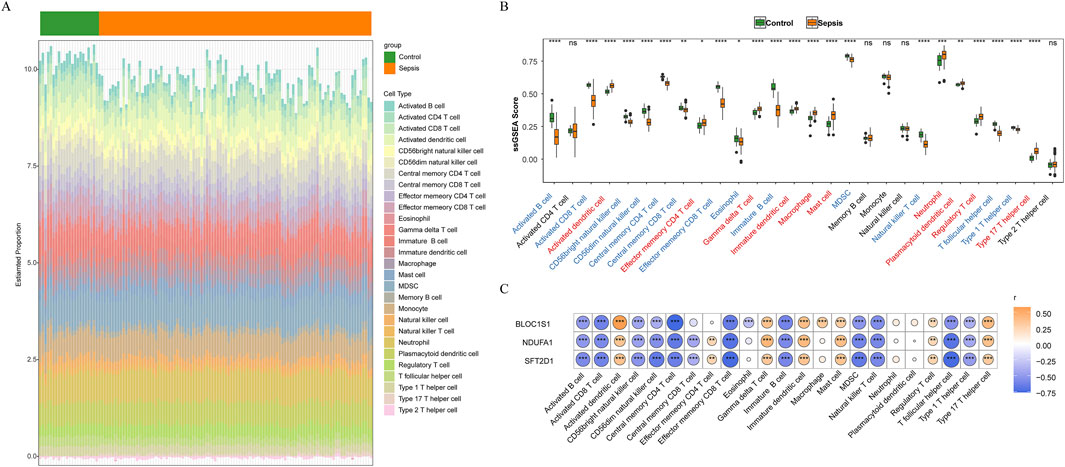
Figure 6. Immune infiltration analysis. (A) stacked bar chart of immune cell score between sepsis and control samples. (B) box plot of immune cell infiltration between sepsis and control samples. ns, no significance; *, P < 0.05; **, P < 0.01; ***, P < 0.001; ****, P < 0.0001. (C) correlation between biomarkers and immune cells. *, P < 0.05; **, P < 0.01; ***, P < 0.001; ****, P < 0.0001.
3.6 Complex regulatory networks of biomarkers
TFs play a crucial role in regulating gene transcription. Through the prediction of TFs for biomarkers, we identified a total of 13TFs and 17 interaction pairs. Notably, FOXC1 was concurrently predicted in BLOC1S1, NDUFA1, and SFT2D1, while GATA3 and GATA2 were predicted in both BLOC1S1 and SFT2D1 (Figure 7A). These results suggested that these TFs might play a central role in regulating the expression of these biomarkers. Furthermore, a comprehensive dissection of the gene expression regulatory network was conducted. Prediction of miRNAs for biomarkers yielded 69 miRNAs corresponding to three biomarkers. Subsequently, prediction of lncRNAs corresponding to miRNAs resulted in 19 lncRNAs corresponding to 59 miRNAs. The construction of an mRNA-miRNA-lncRNA network predicted a total of 69 miRNAs and 19 lncRNAs, with a total of 186 interaction pairs (Figure 7B). This complex network revealed the multi-level regulation of biomarkers, where MALAT1 indirectly regulated BLOC1S1 and SFT2D1 by modulating hsa-miR-498. Multiple lncRNAs simultaneously regulated specific miRNAs to indirectly regulate biomarkers, such as OIP5-AS1, XIST, NORAD regulating hsa-miR-32–5p to indirectly affect NDUFA1. Additionally, specific lncRNAs regulated multiple miRNAs to indirectly regulate biomarkers, including XIST regulating hsa-let-7a-5p, hsa-let-7i-5p, hsa-let-7f-5p to indirectly affect BLOC1S1. These findings enriched our understanding of the regulatory network of biomarkers.
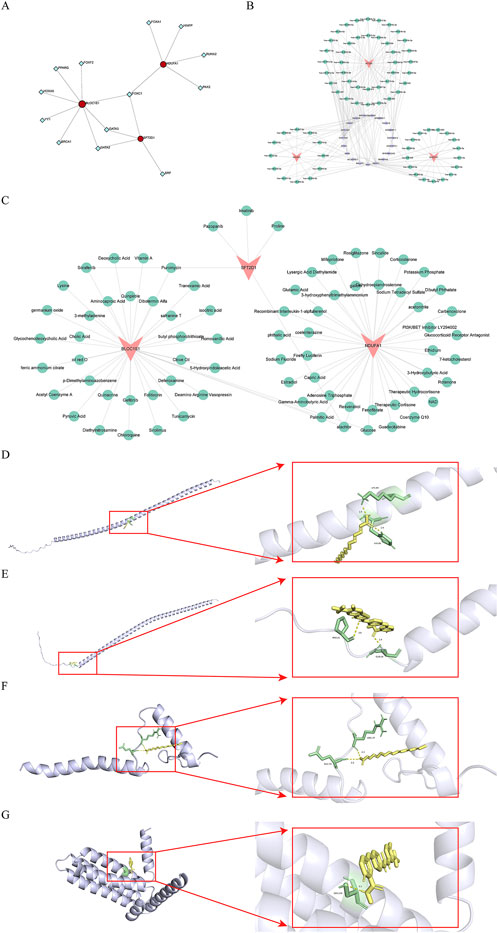
Figure 7. Construction of regulatory network, drug predition, and molecular docking. (A) the network of transcription factors (TFs)-biomarkers. Red is biomarkers, blue is TFs. (B) the network of mRNA-microRNA (miRNA)-long non-coding RNA (lncRNA). Orange is biomarkers, purple is the lncRNA, and green is the miRNA. (C) the identification of drugs targeting biomarkers. Pink is biomarkers, green is drugs. (D,E) molecular docking mode diagram of BLOC1S1 with Palmitic Acid and Sorafenib, respectively. (F) molecular docking mode diagram of NDUFA1 with Palmitic Acid. (G) molecular docking mode diagram of SFT2D1 with Sorafenib.
3.7 Potential therapeutic strategies for sepsis
The identification of potential drugs targeting biomarkers is crucial for the development of personalized treatment plans. A biomarker-drug network was constructed, which included three biomarkers, 76 drugs, and 81 interaction pairs (Figure 7C). Notably, sorafenib was concurrently predicted in both BLOC1S1 and SFT2D1, while alachlor was concurrently predicted in BLOC1S1 and NDUFA1. These findings suggested that these drugs might play a significant role. To further determine the binding capacity between biomarkers and drug targets, molecular docking was performed. The docking binding energies for BLOC1S1 with palmitic acid and sorafenib were −2.8 and −6.15 kcal/mol, respectively; for NDUFA1 with palmitic acid, it was −5.57 kcal/mol; and for SFT2D1 with sorafenib, it was −4 kcal/mol. These negative values indicated a strong binding affinity. Subsequently, the binding modes were visualized, with BLOC1S1 forming hydrogen bonds with residues LYS-89, HIS-86 of palmitic acid and residues PRO-21, GLN-24 of sorafenib (Figures 7D,E); NDUFA1 forming hydrogen bonds with residues GLU-35, ARG-37 of palmitic acid (Figure 7F). And SFT2D1 forming a hydrogen bond with residue SER-134 of sorafenib (Figure 7G). These findings provided important clues for drug development.
3.8 SFT2D1 as a risk factor for sepsis
To explore the causal relationship between BLOC1S1, NDUFA1, and SFT2D1 and sepsis, MR analysis was conducted. We included 280 SNPs for analysis, with the F-values ranging from 30.003 to 4717.202 (Supplementary Table S5). The IVW results indicated a causal link, identifying SFT2D1 as a risk factor for sepsis [odds ratio (OR) = 1.070, 95% confidence interval (CI) = 1.016–1.127, P = 0.001] (Table 4). The forest plot further showed that the effect size of SFT2D1 on sepsis was overall greater than 0 (Supplementary Figure S1A). A scatter plot demonstrated a positive correlation between SFT2D1 expression and increased risk of sepsis (Supplementary Figure S1B). To test the directionality of the MR analysis, a Steiger directionality test was performed (Table 5). The results confirmed the correct direction of the analysis for SFT2D1, with no evidence of bidirectional relationships. Sensitivity analyses further validated the accuracy of the MR analysis. Specifically, Cochran’s Q test and pleiotropy tests showed no evidence of heterogeneity and confounding bias (P > 0.05), indicating that our analysis results were robust (Table 6). The funnel plot revealed a roughly symmetrical distribution on both sides (Supplementary Figure S1C). Leave-one-out analysis showed that sequentially excluding each SNP had minimal impact on the results, further confirming the robustness of the findings (Supplementary Figure S1D). However, BLOC1S1 and NDUFA1 did not screen suitable SNP, so MR analysis was not performed.
3.9 Exploring the developmental trajectory and communication network of macrophages
ScRNA-seq analysis technology enables the tracking of cellular lineages and destinies throughout development and disease processes. Utilizing this technology, we have explored the expression regulation of biomarkers at the single-cell level. After rigorous data filtering, we obtained a total of 50,690 cells and 23,025 genes (Supplementary Figure S2A). For in-depth analysis, the top 2,000 HVGs and the top 30 PCs were selected for subsequent analysis (Supplementary Figure S2B–C). Through PCA dimensionality reduction and clustering analysis, we successfully divided the cells into 14 distinct clusters (Figure 8A) and annotated seven cell types, including macrophage, T cell, monocyte, natural killer cell, B cell, megakaryocyte, and erythrocyte (Figure 8B). Analysis of the expression of biomarkers across various cell types revealed significant differences in macrophage, natural killer cell, and megakaryocyte among different groups (Figure 8C). Notably, in macrophages, the expression distribution of these biomarkers was more abundant (Figure 8D), leading us to select macrophages as key cells for further in-depth analysis. Trajectory analysis can infer the chronological order of cell development or changes, revealing the evolutionary paths and critical turning points of cells in different states. By capturing patterns of gene expression changes, we reconstructed the developmental trajectories or dynamic processes of cells. By arranging macrophages in chronological order, we demonstrated the dynamic changes of cells over time and divided them into seven stages (Figures 9A,B). We found that the control group had more differentiation in state one and 7, concentrated in the early stages of differentiation, while the sepsis group was present in all stages of macrophage differentiation (Figure 9C). Further exploration of the expression of biomarkers along the temporal trajectory revealed that BLOC1S1, NDUFA1, and SFT2D1 were mainly concentrated in state one of macrophages in the control group. In the sepsis group, these biomarkers were more abundant during differentiation stages state 3, 4, and 5 of macrophages (Figure 9D). Analysis of the expression trends of biomarkers during the differentiation process of macrophages showed that the expression of BLOC1S1 and NDUFA1 increased with cell differentiation, while the expression of SFT2D1 did not change significantly (Figure 9E). These results provided us with dynamic regulatory information about these biomarkers during the differentiation process of macrophages. Cell communication analysis, by deeply parsing the interactions and regulatory networks between cells, reveals the coordination mechanisms between cells in life activities. Compared with the control group, the number and strength of interactions between macrophages and monocytes in the sepsis group were reduced, which might be part of the immunosuppressive characteristics of sepsis (Figure 9F). In contrast, the interaction strength between macrophages and B cells increased, suggesting that macrophages might promote antibody production and the formation of immune memory by enhancing interactions with B cells.
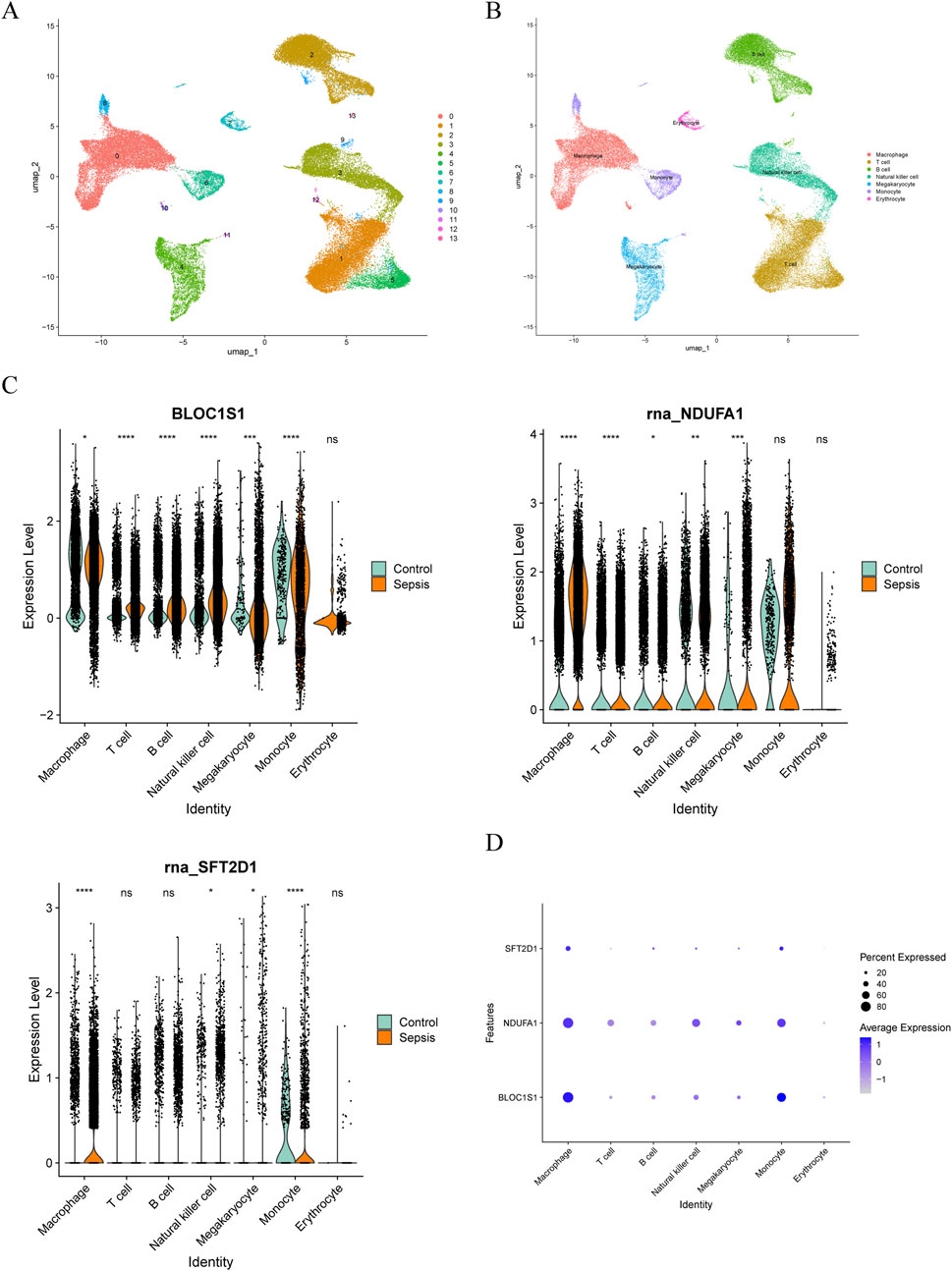
Figure 8. Single-cell RNA sequencing (scRNA-seq) in GSE167363. (A) cellular Uniform Manifold Approximation and Projection (UMAP) clustering map with 14 cell clusters. (B) annotation to seven cell types. (C) box plot of the expression of biomarker in cell types between sepsis and control groups. Ns, no significance; *, P < 0.05; **, P < 0.01; ***, P < 0.001; ****, P < 0.0001. (D) bubble plot of biomarkers expression in various cell types.
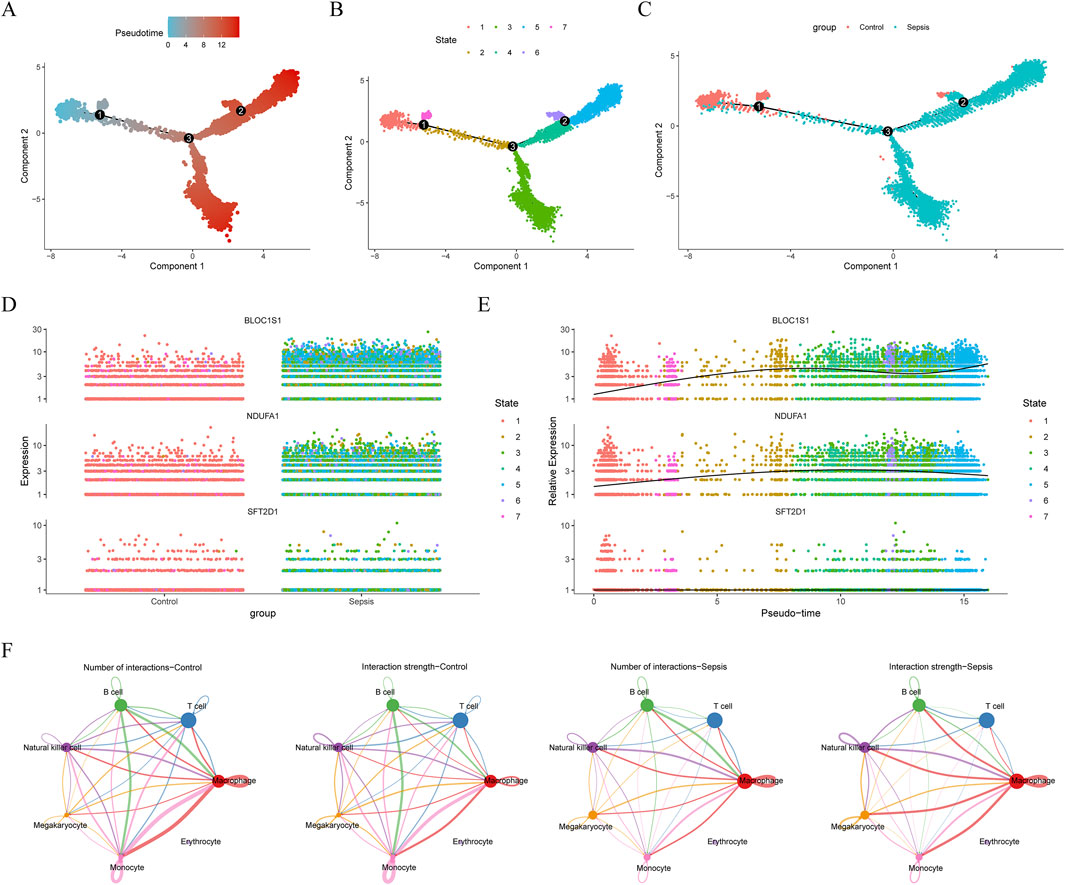
Figure 9. Pseudotime and cell communication analysis of macrophages. (A) time trajectory differentiation of macrophages. (B) macrophage differentiation was divided into seven stages. (C) macrophage cell differentiation locus in sepsis and control groups. (D) expression distribution of biomarkers in a macrophage sample. (E) expression distribution of biomarkers at different differentiation stages in macrophage. (F) cell communication analysis between sepsis and control samples. ns, no significance; *, P < 0.05; **, P < 0.01; ***, P < 0.001; ****, P < 0.0001.
3.10 Experimental validation and functional analysis of acetylation-related genes in sepsis
To validate the expression levels of the identified acetylation-related biomarker genes BLOC1S1, NDUFA1, and SFT2D1, we established a sepsis model in THP-1-derived macrophages by treating cells with phorbol 12-myristate 13-acetate (PMA) for differentiation, followed by lipopolysaccharide (LPS) stimulation (Figure 10A). RT-qPCR analysis revealed that the expression of all three genes was significantly upregulated in LPS-treated macrophages compared to controls (P < 0.01) (Figure 10B), supporting their potential roles in sepsis pathophysiology. Furthermore, validation using patient blood samples confirmed the elevated expression levels of BLOC1S1, NDUFA1, and SFT2D1 in sepsis patients compared to healthy controls (Figure 10C). Consistent with our bioinformatics analysis. These findings further reinforced the reliability of these genes as potential biomarkers for sepsis diagnosis and prognosis.
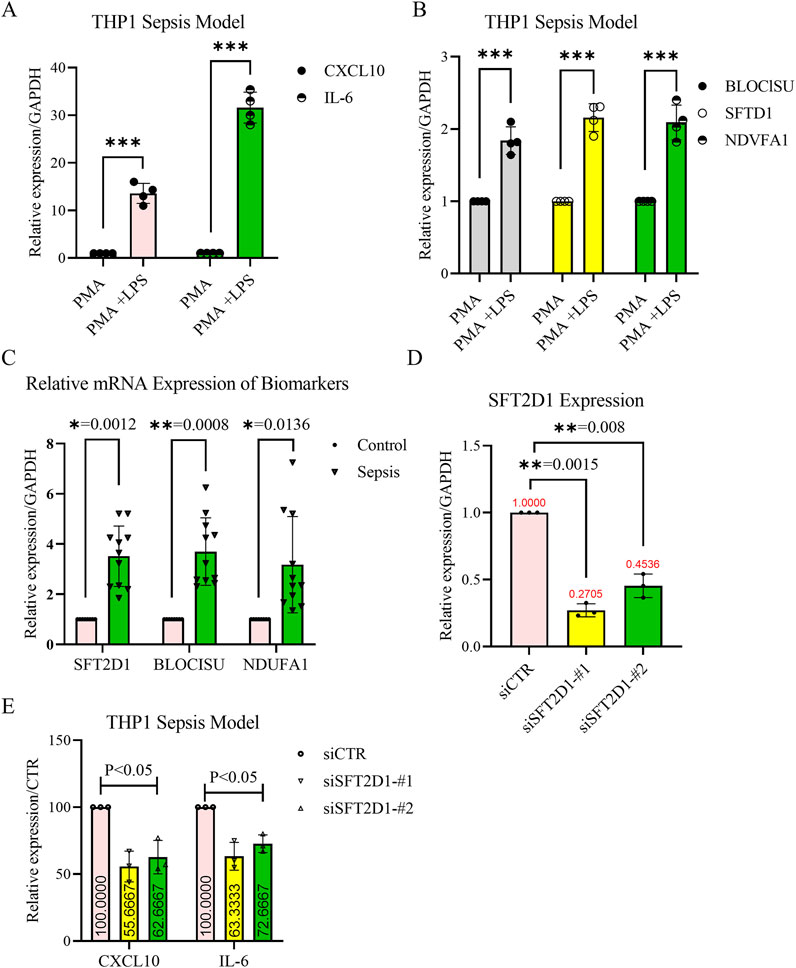
Figure 10. Validation of biomarker expression and functional analysis of SFT2D1 in sepsis. (A,B) Reverse transcription-quantitative polymerase chain reaction (RT-qPCR) confirmation of the THP-1-derived sepsis model. THP-1 monocytes were differentiated into macrophages using PMA (100 nM, 48 h) and then stimulated with LPS (1 μg/mL, 24 h). The relative mRNA expression levels of CXCL10, IL-6, BLOC1S1, NDUFA1, and SFT2D1 were significantly upregulated in LPS-treated cells compared to untreated controls. GAPDH was used as an internal control. (n = 4 independent experiments, mean ± SD, **P < 0.01). (C) RT-qPCR validation of biomarker expression in clinical blood samples. Peripheral blood was collected from sepsis patients and healthy controls. The expression levels of BLOC1S1, NDUFA1, and SFT2D1 were significantly higher in sepsis patients compared to healthy controls (n = 9 for healthy and n = 11 for sepsis group, mean ± SD, **P < 0.01). (D) Knockdown efficiency of SFT2D1 in THP-1-derived macrophages. THP-1 macrophages were transfected with siRNA targeting SFT2D1 or scrambled siRNA as a control. RT-qPCR analysis confirmed a significant reduction in SFT2D1 expression after siRNA transfection (n = 3 independent experiments, **P < 0.05). (E) Effect of SFT2D1 inhibition on inflammatory cytokines. After SFT2D1 knockdown, CXCL10 and IL-6 mRNA levels were measured by RT-qPCR. SFT2D1 suppression significantly reduced the expression of both pro-inflammatory cytokines in LPS-stimulated macrophages, indicating its role in promoting sepsis-related inflammation (n = 3 independent experiments, **P < 0.05). (Statistical significance was determined using multiple t-tests for two-group comparisons and one-way ANOVA followed by Dunnett’s post hoc test for multiple group comparisons; P < 0.05; P < 0.01; P < 0.001. Error bars represent mean ± SD.).
To assess the functional role of SFT2D1, which was identified as a genetic risk factor for sepsis through MR analysis, we conducted gene knockdown experiments in the LPS-induced THP-1 sepsis model. siRNA-mediated suppression of SFT2D1 resulted in a significant reduction in its mRNA expression(Figure 10D) confirming effective knockdown. Further analysis demonstrated that SFT2D1 inhibition significantly decreased the expression levels of key inflammatory cytokines CXCL10 and IL-6 (P < 0.05) (Figure 10E), suggesting a role for SFT2D1 in promoting the inflammatory response in sepsis. These results indicate that targeting SFT2D1 may have potential therapeutic implications for mitigating excessive inflammation in sepsis.
Taken together, these findings provide robust experimental evidence that the acetylation-related biomarkers identified in this study play a significant role in sepsis progression. Moreover, SFT2D1 inhibition effectively attenuates inflammatory cytokine expression, highlighting its potential as a novel therapeutic target for sepsis management.
4 Discussion
Sepsis is a life-threatening condition characterized by a dysregulated host immune response to infection, resulting in systemic inflammation and organ dysfunction (Meziani et al., 2024). Despite advances in understanding its pathophysiology, the identification of reliable biomarkers for early diagnosis and treatment remains a challenge. This study identified three histone acetylation-related genes, BLOC1S1, NDUFA1, and SFT2D1, as potential biomarkers for sepsis through integrated bioinformatics analysis. These findings were validated in THP-1 cell-derived sepsis models and clinical blood samples, confirming their elevated expression in sepsis. Furthermore, functional experiments demonstrated that suppression of SFT2D1 significantly reduced the expression of inflammatory cytokines CXCL10 and IL-6, suggesting its potential role in modulating the inflammatory response in sepsis.
4.1 Biomarker function and enrichment analysis
The identified biomarkers are significantly enriched in pathways related to energy metabolism, immune response, and protein homeostasis, such as oxidative phosphorylation, proteasome activity, and ribosome function. For instance, mitochondrial dysfunction, a hallmark of sepsis, disrupts oxidative phosphorylation (Pham et al., 2024), impairing immune cell activity and energy production. Previous studies have linked mitochondrial dysfunction with decreased immune responses in sepsis (Li et al., 2024c; Zou et al., 2024; Han et al., 2025), aligning with our findings of enriched mitochondrial pathways.
BLOC1S1, also known as GCN5L1, is involved in acetyl-CoA binding and mitochondrial protein acetylation, regulating mitochondrial respiration and ATP synthesis (Sharma et al., 2024). Previous studies identified BLOC1S1 as a critical gene associated with sepsis outcomes, consistent with its role in this study (Lai et al., 2022). NDUFA1, a component of mitochondrial complex I, plays a pivotal role in electron transport and energy production, highlighting its involvement in sepsis-related metabolic dysregulation (Tian et al., 2024). SFT2D1, though less studied, was confirmed as a risk factor for sepsis through MR analysis, highlighting its potential role in disease progression. Our experimental findings further demonstrated that SFT2D1 suppression mitigates pro-inflammatory cytokine expression, suggesting a functional role in sepsis pathogenesis. In the present study, GSEA revealed that SFT2D1 may exert a crucial regulatory role in the inflammatory response of sepsis by activating the toll-like receptor signaling pathway. Studies have shown that the upregulation of the toll-like receptor 2 (TLR2) pathway in keratinocytes enhances the expression of proinflammatory cytokines and chemokines, such as IL-8, IL-1β, TNF-α, CCL5, CXCL9, Chemokine C-X-C ligand 10 (CXCL10), and CXCL11 (Yang et al., 2024). CXCL10 is a pro-inflammatory cytokine that promotes the recruitment and activation of immune cells to infected areas (Kariminik et al., 2016). In addition, it has been shown that toll-like receptors (TLRs) promote interleukin-6 (IL-6) secretion (Xie et al., 2017). And IL-6 is a pleiotropic pro-inflammatory cytokine (Kaur et al., 2020). Therefore, SFT2D1 may indirectly affects the expression levels of CXCL10 and IL-6 by activating the toll-like receptor signaling pathway.
Clinically, BLOC1S1, NDUFA1, and SFT2D1—have also been implicated in various disease contexts beyond sepsis. For instance, BLOC1S1 has been associated with mitochondrial dysfunction and metabolic regulation in hepatocellular carcinoma, where it plays a role in oxidative phosphorylation and cellular metabolism (Han et al., 2023). NDUFA1, a component of mitochondrial complex I, has similarly been linked to neurodegenerative diseases and multiple tumor types (Yin et al., 2025; Kim et al., 2017), reflecting its central role in energy metabolism. Although less extensively studied, SFT2D1 has recently attracted attention in oncology. In cervical cancer, it was identified as an independent risk factor promote angiogenesis, immune suppression, and tumor cell proliferation (Kang et al., 2024). Furthermore, alternative splicing events of SFT2D1 have been significantly associated with increased pancreatic cancer risk (Liu D. et al., 2023), suggesting a broader role in tumorigenesis.
4.2 Immune dysregulation and biomarker impact
Immune cell infiltration analysis revealed significant correlations between the biomarkers and specific immune cell types, highlighting their roles in immune dysregulation during sepsis. BLOC1S1 was positively correlated with activated dendritic cells, suggesting its involvement in antigen presentation and immune activation. Conversely, its negative correlation with central memory CD4+ T cells indicates a potential suppressive effect on adaptive immunity. These findings reflect the dual roles of immune activation and suppression in sepsis, which contribute to disease progression and poor outcomes.
Furthermore, scRNA-seq analysis confirmed that these biomarkers are highly expressed in macrophages, which play a central role in immune response for sepsis. Macrophage differentiation trajectories revealed increased expression of BLOC1S1 and NDUFA1 during later stages of sepsis, suggesting their involvement in immune cell reprogramming. Additionally, cell communication analysis highlighted altered interactions between macrophages and other immune cells, reflecting the complex immune dysregulation in sepsis. Our functional experiments support this notion, as SFT2D1 knockdown in macrophages led to a reduction in pro-inflammatory cytokines, providing direct evidence for its role in inflammation regulation.
4.3 Therapeutic implications
Beyond biomarker identification, our study explored the therapeutic potential of targeting these genes. Drug-biomarker network analysis identified sorafenib and palmitic acid as potential therapeutic agents for BLOC1S1, NDUFA1, and SFT2D1. Molecular docking studies demonstrated strong binding affinities between these compounds and the biomarkers, suggesting possible mechanisms for therapeutic intervention. Importantly, our experimental results highlight the potential of SFT2D1 inhibition in reducing inflammatory responses, providing a new avenue for therapeutic development in sepsis management.
4.4 Study strengths and limitations
This study integrated bioinformatics, RT-qPCR validation, Mendelian randomization, and functional experiments to identify and characterize acetylation-related biomarkers in sepsis. The experimental validation of these biomarkers in both THP-1 macrophages and clinical samples strengthens the reliability of our findings. Additionally, functional inhibition of SFT2D1 provides direct mechanistic insight into its role in sepsis-associated inflammation.
However, some limitations should be considered. First, while RT-qPCR validation confirmed biomarker expression in sepsis, additional protein-level validation (e.g., Western blot, ELISA) would further substantiate these findings. Second, the molecular mechanisms linking SFT2D1 to inflammation remain unclear, necessitating further studies on its regulatory pathways. Third, while our study focused on sepsis, we note that these biomarkers, such as SFT2D1, have also been implicated in other disease contexts. For example, recent studies have linked SFT2D1 to tumor progression and immune modulation in cervical and pancreatic cancers (Kang et al., 2024; Liu D. et al., 2023), including associations with alternative splicing events and cellular transport pathways. Although these findings highlight the broader biological relevance of SFT2D1, they also suggest that its expression may be influenced by other conditions. Future work including disease control cohorts will be important to further assess the specificity and diagnostic value of these biomarkers in sepsis.
Finally, although the binding ability between drugs and biomarkers has been predicted by bioinformatics. However, the binding prediction results derived from computer simulations have not been validated by in vitro experiments. And due to the lack of validation by in vitro experiments, it is not possible to fully determine the binding between biomarkers and drugs in real physiological environments.
5 Conclusion
This study identified BLOC1S1, NDUFA1, and SFT2D1 as histone acetylation-related biomarkers for sepsis and validated their expression in THP-1 cell models and patient blood samples. Functional analysis demonstrated that inhibition of SFT2D1 significantly reduced inflammatory cytokine expression, highlighting its potential as a therapeutic target. These findings provide new perspectives for early diagnosis, immune regulation, and targeted therapy in sepsis. Further experimental and clinical research is required to fully elucidate the role of these biomarkers and translate them into clinical applications.
Data availability statement
The datasets analyzed in this study are publicly available from the Gene Expression Omnibus (GEO) under the following accession numbers: GSE95233, GSE65682, and GSE167363. Additional processed data and codes supporting this study are available upon reasonable request from the corresponding authors.
Ethics statement
The studies involving humans were approved by Ethics Committee of Clinical Medical Research of the First Affiliated Hospital of Bengbu Medical University. The studies were conducted in accordance with the local legislation and institutional requirements. Written informed consent for participation in this study was provided by the participants’ legal guardians/next of kin.
Author contributions
FC: Formal Analysis, Investigation, Methodology, Validation, Visualization, Writing – original draft. JD: Formal Analysis, Investigation, Methodology, Software, Validation, Writing – original draft. ZD: Investigation, Methodology, Validation, Visualization, Writing – original draft. LL: Formal Analysis, Investigation, Software, Validation, Writing – original draft, Writing – review and editing. ZQ: Conceptualization, Project administration, Supervision, Writing – original draft, Writing – review and editing. MZ: Conceptualization, Formal Analysis, Investigation, Writing – original draft, Writing – review and editing. HZ: Conceptualization, Funding acquisition, Investigation, Project administration, Supervision, Writing – original draft, Writing – review and editing. ZW: Conceptualization, Project administration, Supervision, Writing – original draft, Writing – review and editing.
Funding
The author(s) declare that financial support was received for the research and/or publication of this article. This work was funded by the Key Natural Science Project of Anhui Provincial Department of Education (2024AH051208).
Conflict of interest
The authors declare that the research was conducted in the absence of any commercial or financial relationships that could be construed as a potential conflict of interest.
Generative AI statement
The author(s) declare that no Generative AI was used in the creation of this manuscript.
Publisher’s note
All claims expressed in this article are solely those of the authors and do not necessarily represent those of their affiliated organizations, or those of the publisher, the editors and the reviewers. Any product that may be evaluated in this article, or claim that may be made by its manufacturer, is not guaranteed or endorsed by the publisher.
Supplementary material
The Supplementary Material for this article can be found online at: https://www.frontiersin.org/articles/10.3389/fmolb.2025.1582181/full#supplementary-material
SUPPLEMENTARY FIGURE S1 | The results of Mendelian randomization (MR) analysis of SFT2D1 and sepsis. (A) the forest plot showed that the effect size of SFT2D1 on sepsis. (B) scatter plot showed the genetic association between SFT2D1 and sepsis. (C) funnel plot showed the no heterogeneity of SFT2D1 and sepsis. (D) leave-one-out analysis for SFT2D1 on sepsis.
SUPPLEMENTARY FIGURE S2 | Data filtering analysis in the GSE167363. (A) single-cell RNA sequencing (scRNA-seq) data filtering results in GSE167363. (B) filtering of highly variable genes. (C) principal component analysis (PCA), the top 30 principal components were selected for subsequent analysis.
Abbreviations
AUC, area under the curve; ATCC, American type culture collection; DEGs, differentially expressed genes; GEO, gene expression Omnibus; GO, gene ontology; GSEA, gene set enrichment analysis; GSVA, gene set variation analysi; HARGs, histone acetylation-related genes; IVs, instrumental variables; KEGG, Kyoto Encyclopedia of Genes and Genomes; LASSO, least absolute shrinkage and selection operator; LPS, lipopolysaccharide; lncRNAs, long non-coding RNAs; MR, Mendelian randomization; miRNAs, microRNAs; OR, odds ratio; PMA, phorbol 12-myristate 13-acetate; PPI, protein-protein interaction; ROC, receiver operating characteristic; RT-qPCR, reverse transcription-quantitative polymerase chain reaction; SVM-RFE, support vector machine-recursive feature elimination; SiRNA, small interfering RNA; scRNA-seq, single-cell RNA sequencing; SNPs, single nucleotide polymorphisms; TFs, transcription factors; WGCNA, weighted gene co-expression network analysis.
References
Ban, S., Cheng, W., Wang, X., Niu, J., Wu, Q., and Xu, Y. (2024). Predicting the final metabolic profile based on the succession-related microbiota during spontaneous fermentation of the starter for Chinese liquor making. mSystems 9 (2), e0058623. doi:10.1128/msystems.00586-23
Bowden, J., Davey Smith, G., Haycock, P. C., and Burgess, S. (2016). Consistent estimation in mendelian randomization with some invalid instruments using a weighted median estimator. Genet. Epidemiol. 40 (4), 304–314. doi:10.1002/gepi.21965
Burgess, S., and Thompson, S. G. (2017). Interpreting findings from Mendelian randomization using the MR-Egger method. Eur. J. Epidemiol. 32 (5), 377–389. doi:10.1007/s10654-017-0255-x
Chen, B., Zhou, M., Guo, L., Huang, H., Sun, X., Peng, Z., et al. (2024b). An integrated machine learning framework identifies prognostic gene pair biomarkers associated with programmed cell death modalities in clear cell renal cell carcinoma. Front. Biosci. (Landmark Ed) 29 (3), 121. doi:10.31083/j.fbl2903121
Chen, J., Yuan, X. L., Zhou, X., Xu, J., Zhang, X., and Duan, X. (2024a). Mendelian randomization implicates causal association between epigenetic age acceleration and age-related eye diseases or glaucoma endophenotypes. Clin. Epigenetics 16 (1), 106. doi:10.1186/s13148-024-01723-w
Ding, M., Zhang, Z., Chen, Z., Song, J., Wang, B., and Jin, F. (2023). Association between periodontitis and breast cancer: two-sample Mendelian randomization study. Clin. Oral Investig. 27 (6), 2843–2849. doi:10.1007/s00784-023-04874-x
Fan, J. C., Lu, Y., Gan, J. H., and Lu, H. (2024). Identification of potential novel targets for treating inflammatory bowel disease using Mendelian randomization analysis. Int. J. Colorectal Dis. 39 (1), 165. doi:10.1007/s00384-024-04744-2
Friedman, J., Hastie, T., and Tibshirani, R. (2010). Regularization paths for generalized linear models via coordinate descent. J. Stat. Softw. 33 (1), 1–22. doi:10.18637/jss.v033.i01
Gu, Z., and Hubschmann, D. (2022). Make interactive complex heatmaps in R. Bioinformatics 38 (5), 1460–1462. doi:10.1093/bioinformatics/btab806
Gui, C., Liu, S., Fu, Z., Zhang, D., and Deng, Y. (2024). Integrated bioinformatics analysis for identifying fibroblast-associated biomarkers and molecular subtypes in human membranous nephropathy. Heliyon 10 (21), e38424. doi:10.1016/j.heliyon.2024.e38424
Han, H., Zhang, Y., Huang, E., Zhou, S., Huang, Z., Qin, K., et al. (2025). The role of TBC1D15 in sepsis-induced acute lung injury: regulation of mitochondrial homeostasis and mitophagy. Int. J. Biol. Macromol. 293, 139289. doi:10.1016/j.ijbiomac.2024.139289
Han, L., Zhang, C., Wang, D., Zhang, J., Tang, Q., Li, M. J., et al. (2023). Retrograde regulation of mitochondrial fission and epithelial to mesenchymal transition in hepatocellular carcinoma by GCN5L1. Oncogene 42 (13), 1024–1037. doi:10.1038/s41388-023-02621-w
Hao, Y., Stuart, T., Kowalski, M. H., Choudhary, S., Hoffman, P., Hartman, A., et al. (2024). Dictionary learning for integrative, multimodal and scalable single-cell analysis. Nat. Biotechnol. 42 (2), 293–304. doi:10.1038/s41587-023-01767-y
Huang, D., Jiao, X., Huang, S., Liu, J., Si, H., Qi, D., et al. (2024). Analysis of the heterogeneity and complexity of murine extraorbital lacrimal gland via single-cell RNA sequencing. Ocul. Surf. 34, 60–95. doi:10.1016/j.jtos.2024.06.005
Kang, J., Jiang, J., Xiang, X., Zhang, Y., and Tang, J. (2024). Identification of a new gene signature for prognostic evaluation in cervical cancer: based on cuproptosis-associated angiogenesis and multi-omics analysis. Cancer Cell Int. 24 (1), 23. doi:10.1186/s12935-023-03189-x
Kariminik, A., Dabiri, S., and Yaghobi, R. (2016). Polyomavirus BK induces inflammation via up-regulation of CXCL10 at translation levels in renal transplant patients with nephropathy. Inflammation 39 (4), 1514–1519. doi:10.1007/s10753-016-0385-4
Kaur, S., Bansal, Y., Kumar, R., and Bansal, G. (2020). A panoramic review of IL-6: structure, pathophysiological roles and inhibitors. Bioorg. and Med. Chem. 28 (5), 115327. doi:10.1016/j.bmc.2020.115327
Kim, C., Potluri, P., Khalil, A., Gaut, D., McManus, M., Compton, S., et al. (2017). An X-chromosome linked mouse model (Ndufa1(S55A)) for systemic partial Complex I deficiency for studying predisposition to neurodegeneration and other diseases. Neurochem. Int. 109, 78–93. doi:10.1016/j.neuint.2017.05.003
Lai, Y., Lin, C., Lin, X., Wu, L., Zhao, Y., Shao, T., et al. (2022). Comprehensive analysis of molecular subtypes and hub genes of sepsis by gene expression profiles. Front. Genet. 13, 884762. doi:10.3389/fgene.2022.884762
Langfelder, P., and Horvath, S. (2008). WGCNA: an R package for weighted correlation network analysis. BMC Bioinforma. 9, 559. doi:10.1186/1471-2105-9-559
Li, J. M., Zhang, L., Pei, S. L., Guo, L., Shen, H. L., He, J., et al. (2024c). Copper-based nanoparticles for effective treatment against sepsis-induced lung injury in mice model. Int. J. Nanomedicine 19, 13507–13524. doi:10.2147/IJN.S488357
Li, N., Gong, Y., Zhu, Y., Li, B., Wang, C., Wang, Z., et al. (2024b). Exogenous acetate attenuates inflammatory responses through HIF-1α-dependent glycolysis regulation in macrophage. Cell Mol. Life Sci. 82 (1), 21. doi:10.1007/s00018-024-05521-8
Li, X., Li, X., Huang, P., Zhang, F., Du, J. K., Kong, Y., et al. (2024a). Acetylation of TIR domains in the TLR4-Mal-MyD88 complex regulates immune responses in sepsis. EMBO J. 43 (21), 4954–4983. doi:10.1038/s44318-024-00237-8
Liu, D., Bae, Y. E., Zhu, J., Zhang, Z., Sun, Y., Deng, Y., et al. (2023b). Splicing transcriptome-wide association study to identify splicing events for pancreatic cancer risk. Carcinogenesis 44 (10-11), 741–747. doi:10.1093/carcin/bgad069
Liu, Q., Zhang, W., Pei, Y., Tao, H., Ma, J., Li, R., et al. (2023a). Gut mycobiome as a potential non-invasive tool in early detection of lung adenocarcinoma: a cross-sectional study. BMC Med. 21 (1), 409. doi:10.1186/s12916-023-03095-z
Livak, K. J., and Schmittgen, T. D. (2001). Analysis of relative gene expression data using real-time quantitative PCR and the 2(-Delta Delta C(T)) method. Methods 25 (4), 402–408. doi:10.1006/meth.2001.1262
Long, D., Zhang, R., Du, C., Tong, J., Ni, Y., Zhou, Y., et al. (2023). Integrated analysis of the ubiquitination mechanism reveals the specific signatures of tissue and cancer. BMC Genomics 24 (1), 523. doi:10.1186/s12864-023-09583-z
Meziani, F., Iba, T., Levy, J. H., and Helms, J. (2024). Sepsis-induced coagulopathy: a matter of timeline. Intensive Care Med. 50 (8), 1404–1405. doi:10.1007/s00134-024-07507-3
Pham, L., Arroum, T., Wan, J., Pavelich, L., Bell, J., Morse, P. T., et al. (2024). Regulation of mitochondrial oxidative phosphorylation through tight control of cytochrome c oxidase in health and disease - implications for ischemia/reperfusion injury, inflammatory diseases, diabetes, and cancer. Redox Biol. 78, 103426. doi:10.1016/j.redox.2024.103426
Qin, J., Fu, J., and Chen, X. (2024). Comprehensive analysis of histone acetylation-related genes in glioblastoma and lower-grade gliomas: insights into drug sensitivity, molecular subtypes, immune infiltration, and prognosis. J. Gene Med. 26 (3), e3678. doi:10.1002/jgm.3678
Qiu, X., Li, J., Bonenfant, J., Jaroszewski, L., Mittal, A., Klein, W., et al. (2021). Dynamic changes in human single-cell transcriptional signatures during fatal sepsis. J. Leukoc. Biol. 110 (6), 1253–1268. doi:10.1002/jlb.5ma0721-825r
Ritchie, M. E., Phipson, B., Wu, D., Hu, Y., Law, C. W., Shi, W., et al. (2015). Limma powers differential expression analyses for RNA-sequencing and microarray studies. Nucleic Acids Res. 43 (7), e47. doi:10.1093/nar/gkv007
Scicluna, B. P., Klein Klouwenberg, P. M., van Vught, L. A., Wiewel, M. A., Ong, D. S. Y., Zwinderman, A. H., et al. (2015). A molecular biomarker to diagnose community-acquired pneumonia on intensive care unit admission. Am. J. Respir. Crit. care Med. 192 (7), 826–835. doi:10.1164/rccm.201502-0355OC
Shannon, P., Markiel, A., Ozier, O., Baliga, N. S., Wang, J. T., Ramage, D., et al. (2003). Cytoscape: a software environment for integrated models of biomolecular interaction networks. Genome Res. 13 (11), 2498–2504. doi:10.1101/gr.1239303
Sharma, R., Wu, K., Han, K., Russo, A. C., Dagur, P. K., Combs, C. A., et al. (2024). BLOC1S1 control of vacuolar organelle fidelity modulates T(H)2 cell immunity and allergy susceptibility. bioRxiv, 2024.03.21.586144. doi:10.1101/2024.03.21.586144
Singer, M., Deutschman, C. S., Seymour, C. W., Shankar-Hari, M., Annane, D., Bauer, M., et al. (2016). The third international consensus definitions for sepsis and septic shock (Sepsis-3). JAMA 315 (8), 801–810. doi:10.1001/jama.2016.0287
Skrivankova, V. W., Richmond, R. C., Woolf, B. A. R., Yarmolinsky, J., Davies, N. M., Swanson, S. A., et al. (2021). Strengthening the reporting of observational studies in epidemiology using mendelian randomization: the STROBE-MR statement. Jama 326 (16), 1614–1621. doi:10.1001/jama.2021.18236
Su, F., Zhang, C., Zhang, Q., Shen, Y., Li, S., Shi, J., et al. (2024). Multifaceted immunomodulatory nanocomplexes target neutrophilic-ROS inflammation in acute lung injury. Adv. Sci. (Weinh) 12, e2411823. doi:10.1002/advs.202411823
Sun, M., Li, J., Mao, L., Wu, J., Deng, Z., He, M., et al. (2021). p53 deacetylation alleviates sepsis-induced acute kidney injury by promoting autophagy. Front. Immunol. 12, 685523. doi:10.3389/fimmu.2021.685523
Tabone, O., Mommert, M., Jourdan, C., Cerrato, E., Legrand, M., Lepape, A., et al. (2018). Endogenous retroviruses transcriptional modulation after severe infection, trauma and burn. Front. Immunol. 9, 3091. doi:10.3389/fimmu.2018.03091
Tian, W., Zhang, P., Yu, N., Zhu, J., Liu, C., Liu, X., et al. (2024). Role of COX6C and NDUFB3 in septic shock and stroke. Open Med. (Wars) 19 (1), 20241050. doi:10.1515/med-2024-1050
van Vught, L. A., Scicluna, B. P., Wiewel, M. A., Hoogendijk, A. J., Klein Klouwenberg, P. M. C., Franitza, M., et al. (2016). Comparative analysis of the host response to community-acquired and hospital-acquired pneumonia in critically ill patients. Am. J. Respir. Crit. care Med. 194 (11), 1366–1374. doi:10.1164/rccm.201602-0368OC
Venet, F., Schilling, J., Cazalis, M. A., Demaret, J., Poujol, F., Girardot, T., et al. (2017). Modulation of LILRB2 protein and mRNA expressions in septic shock patients and after ex vivo lipopolysaccharide stimulation. Hum. Immunol. 78 (5-6), 441–450. doi:10.1016/j.humimm.2017.03.010
Wang, A., Zhang, S., Peng, G., Tang, Y., and Yang, Y. (2022). ICU and sepsis: role of myeloid and lymphocyte immune cells. J. Oncol. 2022, 7340266. doi:10.1155/2022/7340266
Wang, D. C., Tang, Y. Y., He, C. S., Fu, L., Liu, X. Y., and Xu, W. D. (2023). Exploring machine learning methods for predicting systemic lupus erythematosus with herpes. Int. J. Rheum. Dis. 26 (10), 2047–2054. doi:10.1111/1756-185X.14869
Wang, S., Zhou, Q., Yan, S., Liu, C., Li, F., Feng, D., et al. (2024). TMEM17 promotes tumor progression in glioblastoma by activating the PI3K/AKT pathway. Front. Biosci. (Landmark Ed) 29 (8), 285. doi:10.31083/j.fbl2908285
Wu, A., Liu, F., Zhou, L., Jiang, R., Yu, S., Zhou, Z., et al. (2024). A novel histone acetylation-associated gene signature with prognostic value in Ewing sarcoma. Discov. Oncol. 15 (1), 848. doi:10.1007/s12672-024-01689-4
Xie, Y., Xu, M., Xiao, Y., Liu, Z., Jiang, C., Kuang, X., et al. (2017). Treponema pallidum flagellin FlaA2 induces IL-6 secretion in THP-1 cells via the Toll-like receptor 2 signaling pathway. Mol. Immunol. 81, 42–51. doi:10.1016/j.molimm.2016.11.005
Xu, Y., Xu, J., Zhu, Y., Mao, H., Li, J., Kong, X., et al. (2024). Investigating gut microbiota-blood and urine metabolite correlations in early sepsis-induced acute kidney injury: insights from targeted KEGG analyses. Front. Cell Infect. Microbiol. 14, 1375874. doi:10.3389/fcimb.2024.1375874
Yang, F., Wang, L., Song, D., Zhang, L., Wang, X., Du, D., et al. (2024). Signaling pathways and targeted therapy for rosacea. Front. Immunol. 15, 1367994. doi:10.3389/fimmu.2024.1367994
Yin, R., Zhou, G., Liu, G., Hou, X., Yang, H., Ge, J., et al. (2025). Pan-cancer and multi-omics analysis: NDUFA1 is a potential therapeutic target and prognostic marker for esophageal cancer. Cell Biol. Toxicol. 41 (1), 43. doi:10.1007/s10565-025-09993-7
Yu, G., Wang, L. G., Han, Y., and He, Q. Y. (2012). clusterProfiler: an R package for comparing biological themes among gene clusters. OMICS 16 (5), 284–287. doi:10.1089/omi.2011.0118
Zeng, Y., Cao, S., and Yang, H. (2023). Roles of gut microbiome in epilepsy risk: a Mendelian randomization study. Front. Microbiol. 14, 1115014. doi:10.3389/fmicb.2023.1115014
Zhang, Y., Cao, T., Zhu, H., Song, Y., Li, C., Jiang, C., et al. (2024). An MRI radiomics approach to discriminate haemorrhage-prone intracranial tumours before stereotactic biopsy. Int. J. Surg. 110 (7), 4116–4123. doi:10.1097/JS9.0000000000001396
Zhao, H., Li, Y., Sun, G., Cheng, M., Ding, X., and Wang, K. (2023). Single-cell transcriptional gene signature analysis identifies IL-17 signaling pathway as the key pathway in sepsis. Immunobiology 228 (6), 152763. doi:10.1016/j.imbio.2023.152763
Zheng, S., He, A., Chen, C., Gu, J., Wei, C., Chen, Z., et al. (2024). Predicting immunotherapy response in melanoma using a novel tumor immunological phenotype-related gene index. Front. Immunol. 15, 1343425. doi:10.3389/fimmu.2024.1343425
Zou, R., Shi, W., Chen, M., Zhang, M., Wu, D., Li, H., et al. (2024). Phosphoglycerate mutase 1-mediated dephosphorylation and degradation of Dusp1 disrupt mitochondrial quality control and exacerbate endotoxemia-induced myocardial dysfunction. Theranostics 14 (19), 7488–7504. doi:10.7150/thno.102647
Keywords: biomarkers, histone acetylation, Mendelian randomization, sepsis, single-cell RNA sequencing
Citation: Cheng F, Deng J, Du Z, Li L, Qiu Z, Zhu M, Zhao H and Wang Z (2025) Unraveling the role of histone acetylation in sepsis biomarker discovery. Front. Mol. Biosci. 12:1582181. doi: 10.3389/fmolb.2025.1582181
Received: 24 February 2025; Accepted: 17 April 2025;
Published: 30 April 2025.
Edited by:
Alessandro Palma, Sapienza University of Rome, ItalyReviewed by:
Surendra Kumar Prajapati, Henry M Jackson Foundation for the Advancement of Military Medicine (HJF), United StatesGeorgia Damoraki, National and Kapodistrian University of Athens, Greece
Copyright © 2025 Cheng, Deng, Du, Li, Qiu, Zhu, Zhao and Wang. This is an open-access article distributed under the terms of the Creative Commons Attribution License (CC BY). The use, distribution or reproduction in other forums is permitted, provided the original author(s) and the copyright owner(s) are credited and that the original publication in this journal is cited, in accordance with accepted academic practice. No use, distribution or reproduction is permitted which does not comply with these terms.
*Correspondence: Hongchang Zhao, aG9uZ2NoYW5nY2VsbEAxNjMuY29t; Zhenjie Wang, YWhieWZ5d3pqQDE2My5jb20=
†These authors have contributed equally to this work
 Feng Cheng1†
Feng Cheng1† Zhaoyang Du
Zhaoyang Du Zhaolei Qiu
Zhaolei Qiu Hongchang Zhao
Hongchang Zhao